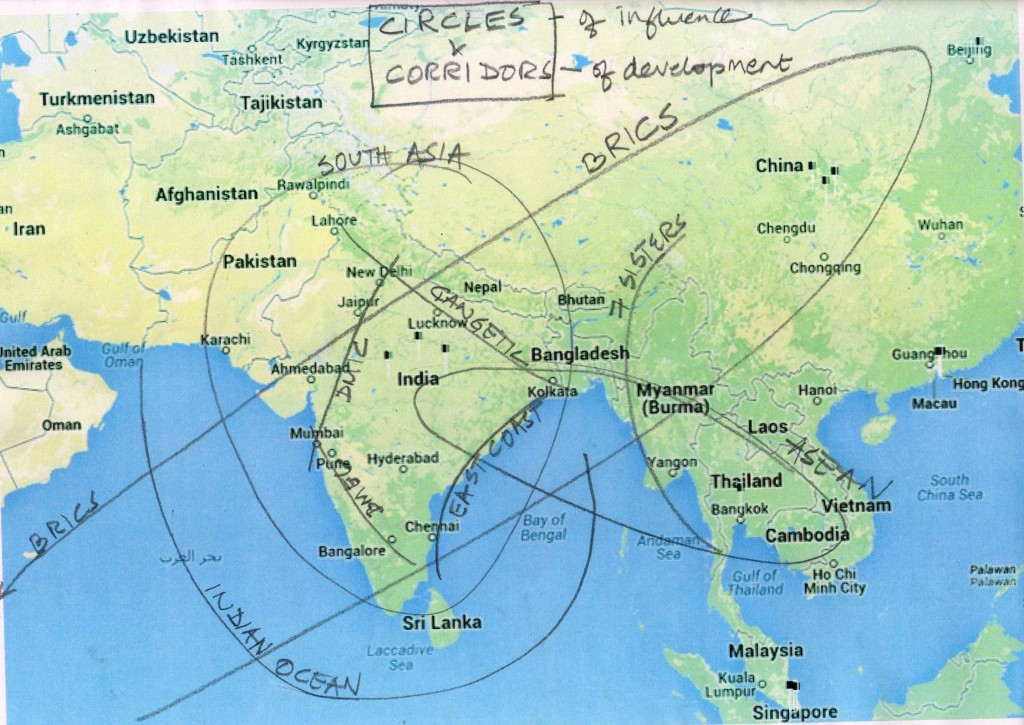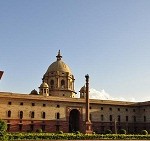Among the many priorities of the new government in Delhi is setting a new Foreign Policy agenda for India. It is an urgent initiative that can help revive our economy and place us at a geopolitical advantage in a world that has changed almost beyond recognition over the last five years.
An active pursuit of economic diplomacy can help India regain its lost geostrategic positioning in the near and medium term. This means attracting foreign investment and technology into India, and extending our influence outside the country – creating Corridors of Development and Circles of Influence which overlap and intertwine.
The Circles will manage our strategic interests, while the Corridors are critical to realizing our national objectives of economic development and employment creation.
- Internally, foreign and domestic investment are needed for the development of industrial, riverine and coastal corridors.
- Externally, activating and expanding the circles of economic influence around India – in our neighbourhood, in the Indian Ocean, with Asean and the BRICS grouping – will secure us strategically and economically.
- Separately, we must strengthen ties with the U.S., Japan and Taiwan by co-building corridors of technology and innovation.

The four Circles of Economic Influence comprise:
1. South Asia: Critically important as International Security Assistance Force (ISAF) troops withdraw from Afghanistan, and extremist elements in Pakistan activate. On our western flank, protecting our existing $2 billion in assets in Afghanistan is key. So is pressing Pakistan to include India in the Afghanistan-Pakistan Transit Trade Agreement, to open up trade with our western neighbours especially through the private sector. To our east, we must ratify the border agreement, sign the Teesta water-sharing treaty with Bangladesh and protect the jointly-owned Sundarbans.
2. ASEAN: Deepen trade linkages with this prosperous region in which Indian business already has billions invested, by immediately
a) Accelerating construction of the India-Myanmar-Thailand Trilateral Highway and the Kaladan multi-modal project;
b) Ratifying and executing the India-Asean FTA in services.
3. BRICS: Incubate an alternate financial architecture within BRICS to counter existing Western-dominated structures which can strangle our economies through sanctions on economic partners and collusion on globally-used finance and commodity benchmarks. India can lead the intellectual effort for an alternate framework for pricing commodities, trading in non-dollar currencies and provision of insurance for maritime trade. This will build on the BRICS Development Bank already being created.
4. Indian Ocean Region: The new geo-strategic playground for great and emerging powers, stretching from the Malacca Straits in the east to the Bay of Bengal and the Arabian Sea in the west, where
a) India must counter China’s string of pearls strategy by engaging with middle powers like Australia and littoral states of the Indian Ocean like Malaysia and South Africa.
b) Modernise our ports and become investors in new ones being built in Myanmar (Sittwe and Dawei), Bangladesh (Sonadia), Iran (Chabahar) and Mozambique (Beira).
c) Revive the U.S.-Japan-India-Australia quadrilateral on disaster management planning and patrolling.
d) Step up Indian public sector investment in Africa, especially in popular programmes like ITEC.
The four Corridors of Economic Development:
Like China grew with SEZs, India can grow through the build-out of Corridors of Development. These public-private partnerships accommodate the compulsions of our diverse democracy and economy, including small and micro enterprises as also major heavy industry and high tech players, where local cooperation, consent and participation is essential.
A model corridor already exists: the Delhi-Mumbai Industrial Corridor, a $90 billion infrastructure and urban development corridor of 1,483 km. The project, initiated by India and Japan in 2006, is being developed to create a conducive environment for the small and medium enterprises that support the major Japanese companies doing business in India. This has become the template for similar projects in India.
Gateway House recommends four other major corridors, each with a partner country with appropriate experience, investment and financing expertise, and a deadline-driven build-out.
1. The Seven Sisters Corridor, connecting the capitals of the north east to Myanmar and on to Thailand, and developing agri-business and energy resources along the route. The project partner should be Thailand, with its expertise in both construction and the food industry, and its direct access to ASEAN.
2. Bangalore-Mumbai Economic Corridor: Inspired by DMIC, proposed in 2013 by the UK government to link financial centre Mumbai to technology centre Bangalore. En route, will be new urban centres, new transport links. Parallel to the feasibility study expected to conclude later this year, the new government can create a framework including financial instruments and a special purpose company to facilitate the development of this corridor.
3. The Gangetic Corridor: A three-year old government plan is already in place to build an eastern rail freight corridor from Amritsar to Kolkata for which the Cabinet approved a budgetary commitment of Rs.5, 600 crore on January 20. Gateway House recommends adding a riverine freight corridor along the Ganges, helping to promote tourism by cleaning up the river and developing agri-business along the fertile plain. Having Germany as a partner, with its expertise in river craft, will revive economies in UP, Bihar and West Bengal.
4. The East Coast Corridor: With the Bay of Bengal in strategic play and Myanmar opening up for business, India must develop a coastal corridor of ports along the east coast from Kolkata to Tutikorin. Existing ports must first be upgraded, and later, new ones built. The ideal partner can be South Korea, with its huge ship-building capacity and experience, and its efficient ports like Busan. Gateway House recommends empowering the Port Authority of India to create the blueprint for such a coastal corridor, with inputs from the Indian Navy which is already securing the Bay.
Two more corridors – virtual, not physical – must also be considered, to secure our two critical bilaterals of the U.S. and Taiwan:
- An India-U.S. Technology Corridor to revitalize the ties between Bangalore and Silicon Valley, through private-sector engagement, for innovation. This will correct the imbalance of soured government-to-government relations that have recently impacted the bilateral.
- The India-Taiwan Technology Partnership, marrying the software prowess of India with the hardware manufacturing strengths of Taiwan – an ideal partnership to create affordable products and services for emerging as also developed markets.
To execute well, we must optimise the use of our diplomatic corps, our credit lines, the growing overseas presence of our businesses, our media and our diaspora. To boost the resources available to them, Gateway House recommends
i. Immediately expanding loan capacity for our Exim Bank from $10 billion now to $50 billion.
ii. Creating a $50 billion fund to facilitate nimble public sector investments in energy and infrastructure opportunities abroad.
iii. A surge of talent in the Indian Foreign Service, and the addition of a commercial corps at Missions abroad using lateral-hire subject experts from the public and private sector to strengthen complex negotiations like FTAs and IPR issues.
iv. An independent and revived Doordarshan to augment our soft power and diplomacy.
Developing these Corridors and Circles will revive the Indian economy and entrepreneurship, and put India back into the geoeconomic and geostrategic matrix, starting 2014.
Manjeet Kripalani is the Co-founder and Executive Director of Gateway House: Indian Council on Global Relations.
This article was exclusively written for Gateway House: Indian Council on Global Relations. You can read more exclusive content here.
For interview requests with the author, or for permission to republish, please contact outreach@gatewayhouse.in.
© Copyright 2014 Gateway House: Indian Council on Global Relations. All rights reserved. Any unauthorized copying or reproduction is strictly prohibited


